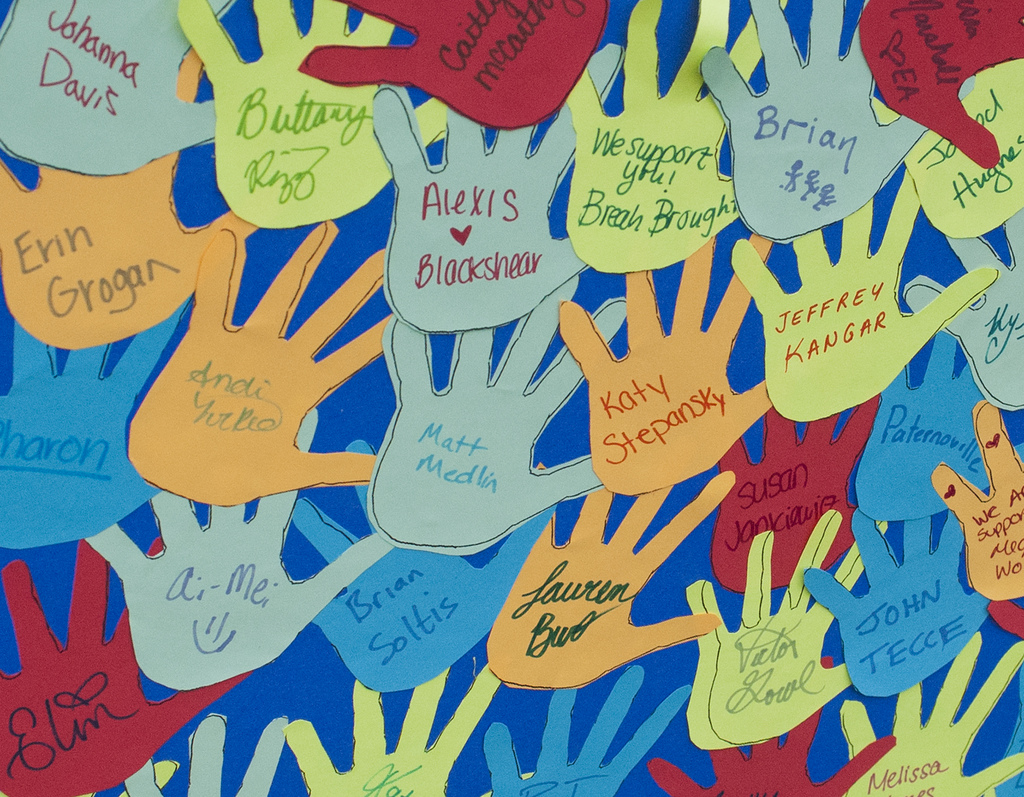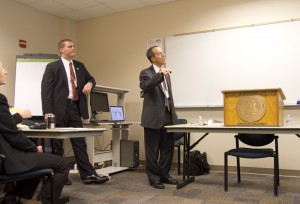
The Support Wall, an event hosted by Penn State on Nov 17, 2011, offered students and staff the opportunity to sign child-sized hands in support of child abuse prevention. Photo Credit: pennstatelive/Flickr
With former Pennsylvania State University assistant football coach Jerry Sandusky facing allegations of sexual abuse against eight children spanning a 15-year period, many in the American public are left wondering how such a chronic narrative of seduction and abuse could go on so long.
At least one parent brought allegations of sex abuse to the police as early as 1998. Since then, at least two university employees say they witnessed Sandusky in the commission of a sexual act with young boys, yet according to records from local law enforcement the complaints never reached police.
In 2000, a Penn State janitor says he witnessed what he described as Sandusky performing oral sex on a young boy in a university shower, according to a Pennsylvania state grand jury. He never reported the incident, fearing he would lose his job, according the grand jury.
The most publicized incident occurred in 2002 when then graduate assistant football coach Mike McQueary reportedly saw Sandusky engaged in sexual activity with another young boy in a university shower. McQueary reported the incident to now former head coach Joe Paterno.
Paterno reported the incident to his supervisor, athletic director Tim Curley, who reported it to vice president of business and finance for the college Gary Schultz.
Still, the allegations of sexual abuse never made it to the police.
If it wasn’t for the person court documents refer to as ‘Victim 1,’ the trail of abuse allegations against Sandusky may not have come to the attention of the public. Documents refer to the abused as ‘Victim 1’ not because he was the first to be allegedly assaulted by Sandusky, but because after more than four years of sexual abuse he was the first to step forward.
With at least four colleagues of Sandusky’s aware of sexual abuse claims, many are left wondering why it took so long to identify the problem, launch a criminal investigation and bring it to the public’s attention.
The four years of abuse outlined by ‘Victim 1’ didn’t even start until after the incident McQueary reported.
Like many states around the country, Pennsylvania designates a specific class of “mandatory reporters,” or those required by law to contact authorities when abuse is suspected. Those include teachers and administrators, social workers, health professionals and clergy.
None of the Penn State officials with knowledge of the allegations have been charged for their reporting procedures, an indicator the staffers didn’t meet the “mandatory reporter” threshold based on their respective relationships to the children visiting Penn State as part of the Second Mile program – a non-profit founded by Sandusky in the mid 1970s.
Every state has statutes identifying persons who are obligated to report child maltreatment and abuse cases, according to the Federal Child Welfare Information Gateway, but only 18 states require anyone who witnesses such incidents to report.
In the wake of the Penn State abuse scandal, lawmakers in many states have started talking about tightening mandatory reporting requirements. Pennsylvania Gov. Tom Corbett has told the press he is confident state lawmakers will pass a law broadening the definition of who must report abuse directly to law enforcement.
Similar drives are underway in other states, including Georgia where at least one state representative is advocating a bill to reform the current law that would be introduced in the upcoming session of the Legislature.
A wider breadth of reporting laws, however, may not be the answer. More than 80 percent of abuse reports in Georgia, for example, turn out to be false, estimated Melissa Carter, Director of the Barton Child Law and Policy Center at Emory University in Atlanta.
“You always want to error on the side of child safety and caution,” Carter said. “But increasingly the field is coming to terms with the fact that [an abuse] investigation is traumatic in itself,” especially when the allegations are found to be false.
If the Penn State scenario had played out in Georgia, for instance, or one of the 31 other states without mandatory reporting requirements for the general public, the legal implications would be pretty much the same for Penn State officials involved.
Nationally, the number of sexual abused children decreased by 38 percent from 1993 to 2005-2006, according to a Department of Health and Human Services (HHS) commissioned study. In the 2005-2006 an estimated 135,300 children were sexually abused, down from 217,700 estimated cases in 1993.

FBI special Agents Nathan Whiteman (left) and Joe Fonseca present on the work of the Metro Atlanta Child Exploitation Task Force at a recent child abuse prevention conference near Atlanta. Clay Duda/JJIE Staff.
But national statistics offer little insight into those effected the most, the victims.
“There’s a very close correlation between kids that are abused and juvenile delinquency,” said Henry County (Ga.) juvenile prosecutor Tom Williams. “Boys, like those at Penn State, rarely reach out directly,” he said, adding that abused young men are more prone to act out in a delinquent or disruptive manner.
“As prosecutors we see the secondary effects [of abuse]," he said. "We see a higher percentage of juvenile offenders with past trauma in their lives -- whether it be physical, emotional or sexual abuse."
FBI special agent Nathan Whiteman has seen a similar trend through his work with the Metro Atlanta Child Exploitation Task Force (MATCH), a joint initiative between the FBI and local law enforcement specifically targeting sexual exploited and trafficked children. He said many of the kids the task force dealt with came from dysfunctional families, but each case was unique.
With that in mind, Whiteman said early intervention and positive influences in a young person’s life, hopefully as early as elementary and middle school, were the best deterrents.
“Sometimes by high school it’s too late,” he said.
In the Sandusky case, with multiple witnesses and victims coming forward, the decision to investigate the allegations of abuse was pretty straight forward, yet with many cases of suspected child abuse it is not such an easy decision to make.
“Sexual abuse is well hidden, much more so than physical abuse,” said Jeanne Alshouse, Co-Founder of HEROES, Great & Small, Inc. of Rome, Ga. For nearly two decades the organization has helped sexually abused children “rise above” the trauma of abuse through group meetings and social activities.
For Alshouse, identifying instances of abuse is the top priority.
“It’s still ‘hush’ in a lot of communities,” or something people don’t want to talk about, she said. “Children are groomed sometimes to keep a secret. The most we can hope to do is educate children about what’s appropriate.”
Mandatory reporter laws were developed to help ensure fast reporting of potential abuse from those that come in contact with children the most, experts agree. Child abuse cases have the potential to be high-stress, emotionally-charged situations for those involved. In theory, having a designated class of mandatory reporters can help cut down on unsubstantiated claims of abuse and place the burden of legal responsibly on the shoulder of specific professionals.
News: Fractured Leg, Fractured Family: A Misdiagnosis Leads to Allegations of Child Abuse
OP ED: The Moral Obligation to Report the Sexual Abuse of Children
OP ED: The Tough Lessons Learned from the Fall of Joe Paterno
News: Georgia Chosen for Study of Legal Representation of Abused Children
Get the headlines at your doorstep. Sign-up for weekly e-blasts for the best of JJIE.org.
Melissa Carter has it right. Requiring anyone and everyone to report anything and everything only guarantees that *more* children will be hurt. Most cases are far more ambiguous than a man allegedly caught in the act of raping a child in the shower. Nationwide, even now, more than three-quarters of all reports alleging child abuse are false. Further expanding mandatory reporting means child abuse hotlines will be deluged with even more false reports, further overloading workers who then will have less time to find children in real danger.
And tens of thousands of children who were never abused will be traumatized by the investigation itself – which often includes a stripsearch looking for bruises. The medical exam required in cases of sexual abuse is even more traumatic.
To see the result of taking away all discretion and common sense, consider this case from Florida in which a mandated reporter called in a report – and sheriff’s deputies launched an investigation – when a schoolyard crush led a 12-year-old girl to kiss a 12-year-old boy: http://bit.ly/rTQOzV
There are 18 states that already require everyone to report and there is no evidence children are any safer in those states. As is so often the case with our efforts to fight child abuse, this solution has nothing to do with actually helping children and everything to do with making the adults feel better about a heinous crime. Details are on our Child Welfare Blog here: http://is.gd/klIkEC
Richard Wexler
Executive Director
National Coalition for Child Protection Reform
http://www.nccpr.org